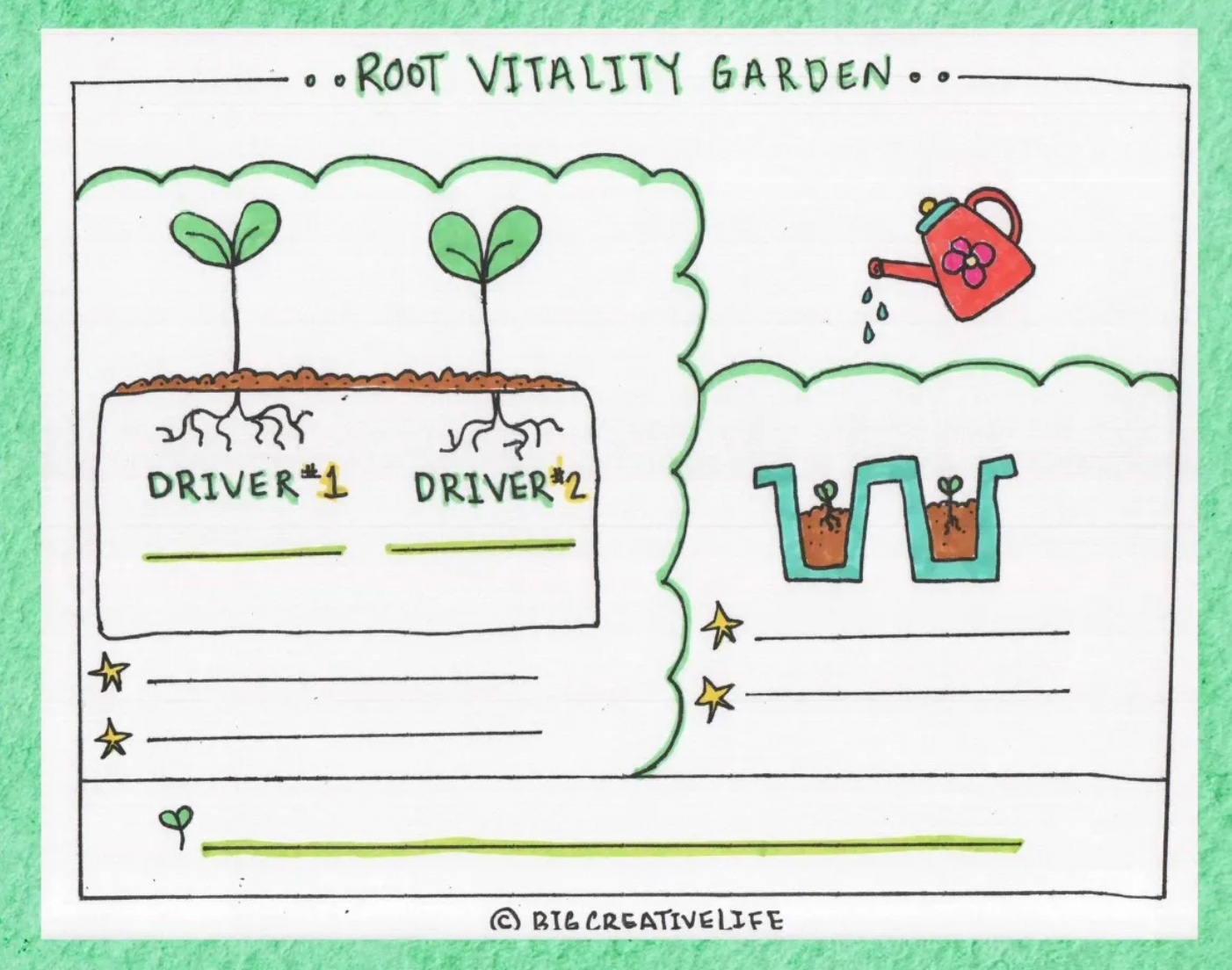🧠 Your ADHD Brain Isn't Broken. Your Business Systems Are
How I stopped forcing neurotypical productivity and built a business my nervous system actually approves of. 😌
⚡🪫Want to find your hidden energy drains? 👉🏻 Get your Business Health Quiz + Bonus Map here 🗺️
I was three hours into “power batching” my content when my body staged a revolt.
Brain fog so thick I couldn’t remember what I’d written in the last paragraph.
Heart racing like I’d run a marathon, but I’d only been sitting at my desk.
And this creeping sense that if I kept going, something in me would break.
The productivity guru’s advice was clear: Batch similar tasks. Time-block everything. Push through resistance.
But my nervous system had other ideas.
🧠 The Day I Stopped Fighting My Biology
For years, I tried to make my ADHD brain behave like a neurotypical one.
Morning routines at 5am (even though my brain doesn’t wake up until 10).
Strict content calendars (that made me resent my own business).
Eight-hour work blocks (that left me depleted and inflamed).
I thought the problem was discipline.
Turns out, the problem was neuroscience.
🔬 What I Didn’t Know About ADHD & The Nervous System
ADHD brains have measurable autonomic nervous system differences. In fact, 67% of entrepreneurs show ADHD traits and it might actually be your competitive advantage when you understand how to work with it.
Not speculation. Not “mindset.” Actual physiological differences in how our nervous systems regulate energy, attention, and stress response.
Research shows impaired cardiovascular autonomic modulation in adults with ADHD, particularly in sympathetic modulation and during stress exposure. Studies reveal ANS dysfunction in individuals with ADHD, more often in the direction of under-regulation than over-regulation, particularly at rest and during tasks requiring response regulation and sustained attention.
Translation: Our nervous systems struggle to find the “just right” energy level for the task at hand.
Too much activation? We can’t focus.
Not enough? We can’t engage.
And traditional productivity systems? They assume your nervous system regulates like a neurotypical brain.
Mine doesn’t. Maybe yours doesn’t either.
⚡ Why “Just Try Harder” Never Worked
Every productivity hack I tried felt like trying to run software designed for a different operating system.
Pomodoro timers made me anxious.
Morning routines triggered autoimmune flares.
Rigid schedules felt like prison.
I thought I was failing.
But my nervous system was trying to tell me something important: the system was incompatible with my biology.
The imbalance in sympathetic and parasympathetic activity may contribute to core ADHD symptoms such as hyperactivity, impulsivity, and emotional dysregulation.
In other words: My nervous system wasn’t broken. It was just wired differently.
And it needed different support structures to thrive.
🌊 The Shift: From To-Do Lists to Nervous System States
Here’s what changed everything:
I stopped asking “What’s on my to-do list?”
I started asking “What state is my nervous system in right now?”
Because here’s what I discovered:
Your nervous system state dictates your available cognitive resources.
When my nervous system is regulated:
Strategic thinking flows
Decisions come easily
Client work feels energizing
Creative ideas emerge naturally
When my nervous system is dysregulated:
Everything feels harder
Simple decisions become overwhelming
Client work drains me
My autoimmune symptoms flare
Same brain. Different nervous system state. Completely different results.
📊 What Changed When I Aligned With My Biology
Once I started designing my business around nervous system regulation instead of forcing productivity, the transformation was measurable:
⚖️ Business Sustainability
Before:
Work hours: 50-60/week (and still behind)
Burnout risk: High (thoughts of quitting daily)
Recovery time: Needed full weekends to barely recover
Sick days: Frequent (body forcing rest)
Business model: Stress-dependent
After:
Work hours: 25-30/week (and more productive)
Burnout risk: Low (work feels sustainable)
Recovery time: Built into weekly rhythm
Sick days: Rare (prevention vs. crisis management)
Business model: Health-dependent (gets stronger as I do)
💚 Capacity to Serve Clients Well
Before:
Client capacity: Maxed at 8 clients, barely managing
Client retention: 68% (I was depleted, it showed)
Session quality: Inconsistent (depended on my state)
Strategic thinking: Limited (survival mode)
Presence: Scattered (nervous system dysregulation = distraction)
After:
Client capacity: Comfortably serve 12 clients with better results
Client retention: 98% (regulated coach = transformative coaching)
Session quality: Consistently high (stable nervous system)
Strategic thinking: Sharp (regulated state = access to prefrontal cortex)
Presence: Fully engaged (calm nervous system = true listening)
The difference wasn’t working harder.
The difference was working in alignment with how my nervous system actually functions.
🌱 The Framework: Building a Nervous-System-Smart Business
After three years of experimentation, here’s what actually works:
🕐 Honor Your Natural Energy Patterns (Not Someone Else’s Schedule)
I used to force myself to work 9-5 straight through because that’s “professional.”
But my nervous system has different ideas:
7:30am-2pm: Peak energy (deep work, client calls, strategic thinking)
2pm-3pm: Natural slump (walk, water, movement - no meetings)
3pm-6pm: Second wind (lighter client work, planning, creative tasks)
After 6pm: Unwinding (simple admin, no-brainer tasks only)
Now I schedule my business around these natural patterns.
Result: I produce better work in less time because I’m working WITH my energy patterns instead of against them.
⚡ Track Nervous System States (Not Just Time Blocks)
Every morning, I check in:
How regulated does my nervous system feel? (1-10)
What type of work would feel supportive right now?
What would dysregulate me today?
Then I adjust my day accordingly.
Some days that means three deep client sessions.
Other days it means visual planning, short tasks, and plenty of walks.
Result: My energy stays consistent instead of crashing midweek.
🛡️ Build Recovery Into Your Business Model
Here’s what most productivity advice misses:
ANS dysregulation, characterized by reduced vagally mediated Heart Rate Variability (HRV), has been associated with ADHD.
Translation: ADHD nervous systems need MORE recovery, not less.
My non-negotiables:
Daily: 20-minute walk without my phone (resets my vagal tone)
Weekly: One full day with zero business talk
Monthly: 48-hour digital detox
Quarterly: Week focused on rest, not productivity
Result: My nervous system stays regulated enough to sustain high performance.
🌊 Use Visual Systems (Not Text-Heavy Lists)
(A visual system example👇🏻 + you’ll get this map when you download the Business Health Reset™ Quiz)
Text-heavy to-do lists dysregulate my ADHD nervous system and might be the case for you too.
They trigger overwhelm before I even start.
Visual planning like mind maps, color-coded roadmaps, spatial layouts, calms my nervous system while organizing my thinking.
This is why I created The Bloom Method™.
It’s business planning designed for nervous systems that need visual, spatial, and flexible structures.
Result: Planning feels supportive instead of anxiety-inducing.
💡 What This Actually Looks Like
Let me show you a real week:
Monday:
Morning: Light admin, emails, short tasks (gentle start)
Afternoon: One strategic client call (optimal window)
Evening: Content ideation while walking (creative state)
Tuesday:
Morning: Visual planning session for Q2 (engaging but not depleting)
Afternoon: Two client calls back-to-back (riding the regulation wave)
Evening: Reading, no work (recovery)
Wednesday:
Full day off (nervous system reset)
Thursday:
Morning: Team check-in, design new visual tools (moderate engagement)
Afternoon: Deep work on client deliverable or client call (optimal state)
Evening: Light content drafting (creative flow)
Friday:
Morning: Quick client check-ins (social engagement)
Afternoon: Week review + visual planning (integration)
Evening: Nothing (weekend starts early)
Notice what’s missing?
Eight-hour work days. Back-to-back meetings. Rigid schedules.
Notice what’s present?
Flexibility. Recovery. Alignment with my natural nervous system patterns.
🔥 The Unexpected Benefits
When I stopped forcing neurotypical systems and started designing for my nervous system:
My clients get better results because I show up fully present, strategically sharp, and energetically consistent.
My body stopped fighting me because I’m no longer asking it to override its built-in wisdom.
My creativity returned because regulated nervous systems have access to strategic thinking and innovation.
My business became sustainable because it’s built on health, not hustle.
The irony?
I work half the hours I used to.
But I serve more clients better, create better content, and actually have a life outside work.
💭 Coach Questions
Take a moment to reflect:
🔍 What business activity consistently dysregulates your nervous system, but you keep doing it because you “should”?
⚡ When was the last time you felt genuinely energized by your work? What were you doing, and what time was it?
🌊 If you designed your business around your natural energy patterns instead of “best practices,” what would change?
🎭 What if your nervous system’s resistance isn’t laziness, but important data about misalignment?
🌱 The Framework That Changed Everything: The Bloom Method™
After years of experimentation and a decade of coaching, I developed The Bloom Method™, a business framework designed specifically for nervous systems that need flexibility, visual structure, and strategic pacing.
Instead of:
Fighting your energy patterns → Design around them
Forcing rigid schedules → Build flexible frameworks
Ignoring regulation signals → Track and respond to them
Text-heavy systems → Use visual, spatial planning
Constant productivity → Strategic recovery
The result?
A business that works WITH your nervous system instead of exhausting it.
🎯 Your Next Step: Discover Your Nervous System Patterns
Want to understand YOUR unique nervous system patterns and how they’re affecting your business?
The Business Health Reset™ Quiz helps you identify:
🔍 Your natural energy patterns (when you’re actually at your best vs. when you think you should be)
⚡ What genuinely energizes YOU (not what productivity gurus say should)
🛡️ Your stress signals (before they become burnout or health problems)
🌊 Your recovery requirements (what your nervous system actually needs to sustain performance)
🎯 Your unique operating system (so you can stop using someone else’s)
🍒 The Bottom Line
Your ADHD brain isn’t broken.
The systems you’ve been trying to use were just designed for different nervous systems.
Once I stopped fighting my biology and started designing around it, everything shifted.
Better client results. Better health. Actual sustainability.
You don’t need to fix yourself.
You need to build a business that fits how you’re actually wired.
Your nervous system has been trying to tell you something all along.
Maybe it’s time to start listening.
Want a little homework? Try this out:
Track for 3 days: Note your energy/regulation level (1-10) three times daily.
Identify patterns: When are you most regulated? What activities support vs. drain you?
Redesign one thing: Pick one business activity and adjust it to work WITH your nervous system
From maxed out to mapped out, your nervous system already knows the way. 🌱
With gratitude + strategy, 🙏🏻
Kate
👉🏻 P.S. If this resonated, would you share it? Forward to that one entrepreneur friend who’s been white-knuckling their way through productivity systems that feel wrong. Sometimes the most powerful insight is: “It’s not you, it’s the system.”
Want weekly insights like this?
Subscribe to Business Feels Good for nervous-system-smart business strategies that actually work for ADHD brains. Short reads, real science, practical tools.
This post is public, share it!
📌 Restack this if you know someone who needs to hear: your ADHD brain isn’t broken, the business systems are.






